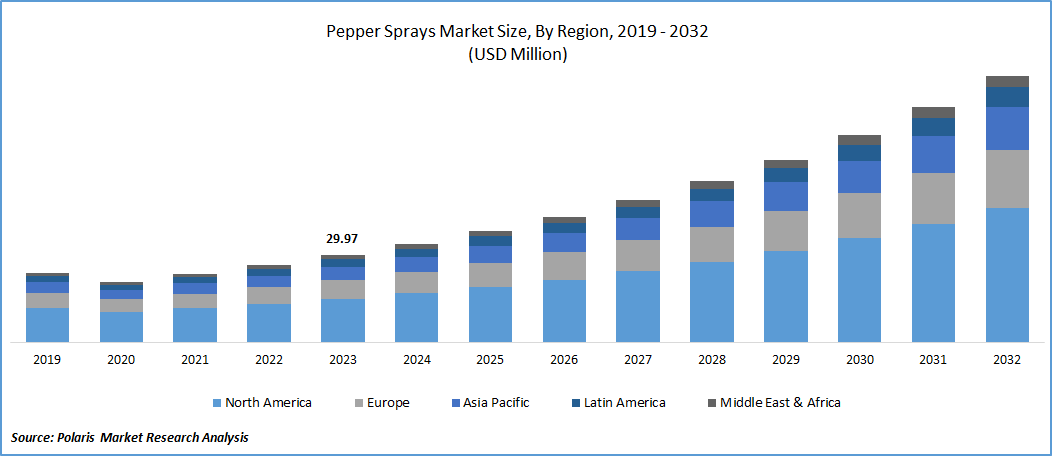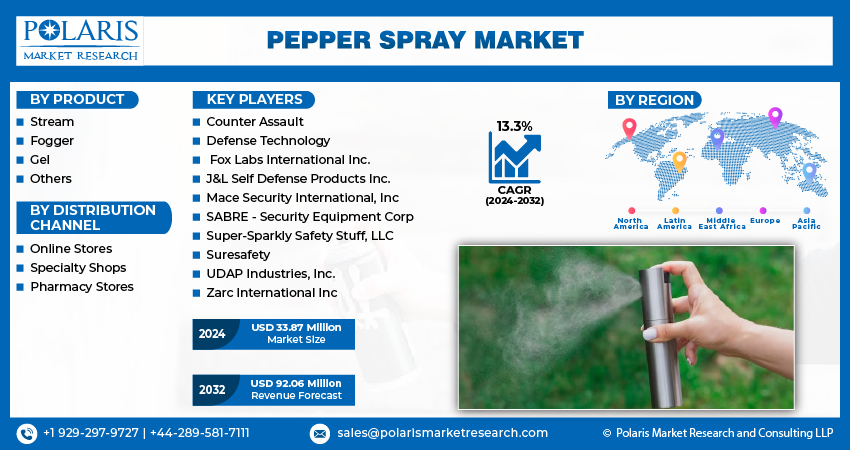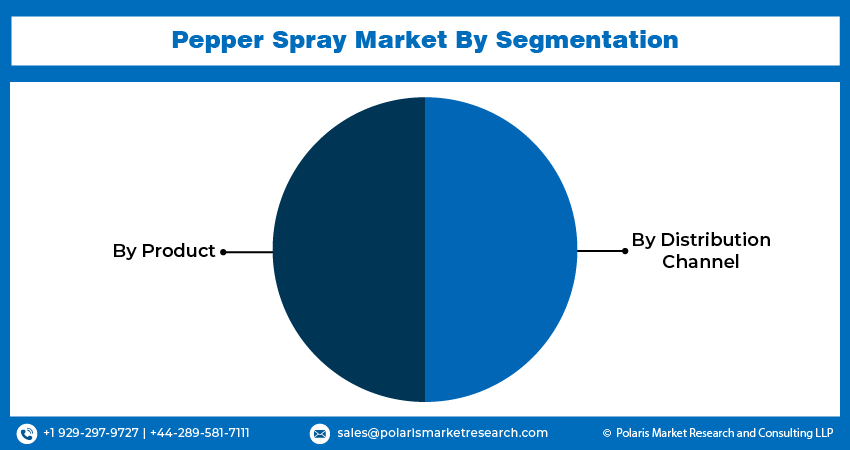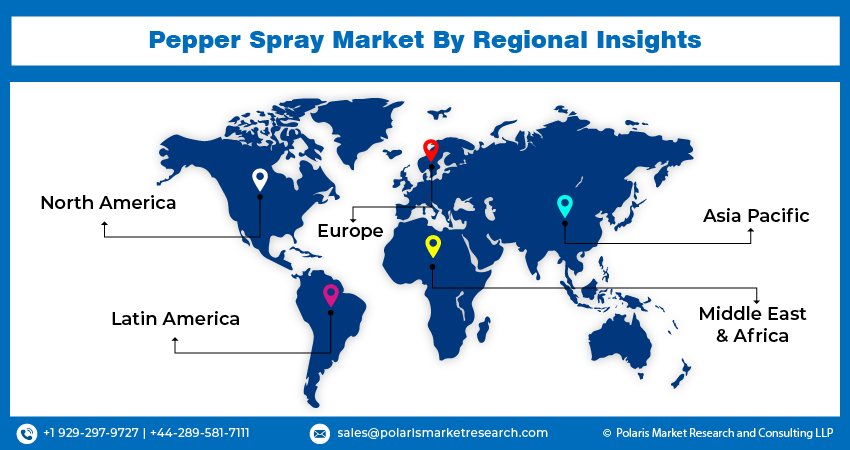
Pepper Spray Market Share, Size, Trends, Industry Analysis Report, By Product (Fogger, Stream, Gel, Others), By Distribution Channel (Specialty Shops, Online Stores); By Region; Segment Forecast, 2022 - 2030
- Published Date:Feb-2024
- Pages: 117
- Format: PDF
- Report ID: PM2272
- Base Year: 2023
- Historical Data: 2019-2022
Report Outlook
The global Pepper Spray market was valued at USD 29.97 million in 2023 and is expected to grow at a CAGR of 13.3% during the forecast period.
Pepper spray serves as a protective measure against lethal animals such as rhinos, bears, and tigers, and its acceptance has been on the rise among police agencies and law enforcement officers over the past few years as a safe and effective means of incapacitating violent or threatening subjects; available in various concentrations, pepper spray induces physical effects that can significantly diminish aggressive behavior in individuals, with law enforcement reporting its effectiveness on those agitated, excited, under the influence, or mentally impaired. The FBI's Forensic Science Research and Training Center confirms its absence of long-term health risks, making it a reliable self-defense tool and presenting market opportunities in the years ahead.

To Understand More About this Research: Request a Free Sample Report
The escalating incidence of crimes like eve-teasing, rape, kidnapping, murder, and human trafficking serves as a prominent catalyst for the growing adoption of pepper sprays, with various personal defense options available, including pocket knives, silver self-defense key cases,self-vigilant alarms, and aluminum baseball bats; however, among these choices, women predominantly opt for pepper spray due to its commonality and effectiveness, being easy to carry and use, fitting conveniently into any handbag due to its compact size.
Pepper spray induces adverse effects, including temporary blindness, a boiling or bubbling sensation, acute eye pain, severe discomfort, shortness of breath, wheezing, chest pain, throat burning, dry cough, runny nose, gagging, gasping for air, inability to speak, panic, blisters, loss of consciousness, dizziness, rashes, and burns upon skin contact, serving as a limiting factor for the expansion of the global pepper spray market.

Industry Dynamics
- Growth Drivers
- The Increasing Incidence of Crime to Propel Market Expansion.
Amidst the growing global uncertainty surrounding criminal activities, the pepper spray market is poised to expand in the forecast period, driven by consumer preference for its portability and non-lethal characteristics. Pepper sprays are authorized for self-defense by individuals and law enforcement officers in specific countries, including India, Germany, and France. The demand for pepper sprays within police forces has risen due to political conflicts, riots, violence, and civil unrest. Recent trends indicate an increasing use of pepper spray by police for safeguarding individual officers and managing potentially violent individuals or groups, with geopolitical situations in the Middle East, Eastern Europe, and East Asia significantly contributing to this global trend. Anticipated increases in incidents of political violence, terrorism, insurgency, and civil unrest in the Middle East are expected to fuel a significant rise in the demand for non-lethal weapons, such as pepper spray.
Report Segmentation
The market is primarily segmented based on product, distribution channel, and region.
|
By Product |
By Distribution Channel |
By Region |
|
|
|
To Understand the Scope of this Report: Speak to Analyst
By Product Analysis
- The Fogger segment held the largest revenue share in 2022
- The pepper spray fogger products, with a spraying range of 4 to 8 feet, are commonly utilized but become less effective in windy conditions due to the potential blowback of their fine droplets. This type of pepper spray proves most efficient when directed straight at the aggressor, providing a wide "fog-like" spray that blankets a substantial area, reducing the necessity for precise aiming. Moreover, the fogger can be discharged from a considerable distance, allowing for a swift escape from an assailant. The projected rise in the utilization of non-lethal devices, both by law enforcement and civilians, for crowd control and self-defense, is anticipated to propel the pepper sprays market during the forecast period.The stream segment is poised for the most rapid growth rate. The efficacy of a stream-type pepper spray relies on factors like canister size and fuel quantity, enabling it to cover distances of 15 to 20 feet. In contrast to foggers that release droplets, this type of spray maintains its effectiveness even in windy conditions due to its stronger spraying force. The rising popularity of pepper spray streams is attributed to notable advantages, including the capacity to irritate attackers for 30 to 45 minutes and the capability to be sprayed from a significant distance. Equipped with features such as a double-lock and a single-hand draw and fire system, the stream pepper spray can be efficiently and swiftly utilized in emergencies. The increasing adoption of pepper sprays, in conjunction with other non-lethal devices like rubber and wax bullets and ring airfoil projectiles, is anticipated to propel the pepper spray market during the forecast period.
By Distribution Channel Analysis
- The Specialty Shops segment accounted for the highest market share during the forecast period
Specialty stores, which focus on a limited range of product categories in contrast to retailers offering diverse consumer goods, are venues where pepper spray is available, including sporting goods stores, gun shops, and pharmacies. Within the global pepper spray market, specialty stores have witnessed substantial growth in market share, and it is expected that this trend will persist throughout the forecast period. This sustained market presence is attributed to the advantages offered by specialty stores, including a wider array of brand options within a specific product segment and the presence of knowledgeable staff providing expert guidance. Consumers in specialty stores can thoroughly assess various product parameters, such as price, functionality, and features, before making a purchase decision.
The online stores segment is poised to capture the second-largest market share, with the accessibility of purchasing pepper spray through online platforms rendering it an appealing choice. The convenience of home delivery and time-saving attributes contribute to the growth of online retailers. The escalating adoption of various online portals in developing regions, coupled with the proliferation of offers and discounts to incentivize consumers, further fuels the trend of purchasing pepper spray from online stores. Moreover, the increased accessibility of online platforms has positioned e-commerce as a pivotal revenue source for many businesses. Anticipated expansion in the online sales segment is driven by the rapid growth of online and mobile user bases in emerging markets.

Regional Insights
- North America dominated the largest market in 2022
The North American pepper spray market has experienced a shift in sales due to technological advancements in pepper spray and the presence of global players in the region. The U.S. market for pepper spray has gained substantial traction, a trend expected to persist throughout the forecast period. Increasing investments in research and development activities for less-lethal self-defense weapons in the U.S. are anticipated to drive market expansion. In Canada, a surge in crime rates has prompted significant changes in government regulations, contributing to the expected growth of the pepper sprays market. While the U.S. and Mexico have legalized the use of pepper spray by both individuals and law enforcement agencies, the Canadian government has authorized its use solely by law enforcement for self-defense and crowd control, a factor likely to boost the overall growth of the North American pepper spray market.
Throughout the forecast period, Asia Pacific is poised to demonstrate the highest CAGR, positioning it as one of the most rapidly expanding pepper spray markets worldwide. Acknowledging the increasing demand for pepper spray in self-defense, global companies within the pepper spray industry are actively channeling investments into emerging economies within the Asia-Pacific region, including India, China, and Indonesia. This growth is driven by heightened awareness of pepper spray, a rise in disposable income, and the expanding millennial population. The development of the Asia-Pacific pepper spray market during the forecast period is primarily steered by heightened concerns regarding violence against women and an increasing awareness of self-defense weapons. Incidents of violence against women, encompassing rape, domestic violence, sexual harassment, and acid attacks, contribute to the growing demand for pepper spray. Additionally, there is anticipated demand for pepper spray in the Asia-Pacific region due to safety concerns during activities such as forest safaris, hill climbing, and mountain climbing. The rising instances of crimes against children further underscore the necessity for non-lethal weapons, including pepper spray.

Key Market Players & Competitive Insights
The market is characterized by intense competition, with established players relying on advanced technology, high-quality products, and a strong brand image to drive revenue growth. These companies employ various strategies such as research and development, mergers and acquisitions, and technological innovations to expand their product portfolios and maintain a competitive edge in the market.
Some of the major players operating in the global market include:
- Counter Assault
- Defense Technology
- Fox Labs International Inc.
- J&L Self Defense Products Inc.
- Mace Security International, Inc
- SABRE - Security Equipment Corp
- Super-Sparkly Safety Stuff, LLC
- Suresafety
- UDAP Industries, Inc.
- Zarc International Inc
Recent Developments
- In April 2023, Mace Security International, Inc. has recently announced a distribution agreement with SurgePays, Inc., enabling the widespread distribution of pepper spray and various personal safety items through SurgePays' extensive network of numerous convenience stores, small groceries, and gas stations.
- In May 2022, Byrna Technologies Inc. has completed the acquisition of Fox Labs International Inc., a distinguished manufacturer of powerful pepper spray designed for law enforcement. This acquisition encompasses Fox Labs' assets and includes the rights to Sudecon, a neutralizing agent for pepper and tear gas. Byrna intends to retain the Fox Labs brand and leverage their expertise to introduce a new line of potent sprays. This strategic move marks Byrna's expansion beyond the direct-to-consumer market into the realms of law enforcement and corrections.
Pepper Spray Market Report Scope
|
Report Attributes |
Details |
|
Market size value in 2024 |
USD 33.87 million |
|
Revenue forecast in 2032 |
USD 92.06 million |
|
CAGR |
13.3% from 2024 – 2032 |
|
Base year |
2023 |
|
Historical data |
2019 – 2022 |
|
Forecast period |
2024 – 2032 |
|
Quantitative units |
Revenue in USD million and CAGR from 2024 to 2032 |
|
Segments Covered |
By Product, By Distribution Channel, By Region |
|
Regional scope |
North America, Europe, Asia Pacific, Latin America; Middle East & Africa |
|
Customization |
Report customization as per your requirements with respect to countries, region and segmentation. |
FAQ's
Pepper Spray Market report covering key segments are product, distribution channel, and region.
Pepper Spray Market Size Worth $ 92.06 Million By 2032
The global Pepper Spray market size is The expected to reach USD 92.06 million by 2032.
North America is leading the global market
The key driving factors is Increasing Incidence of Crime to Propel Market Expansion.
